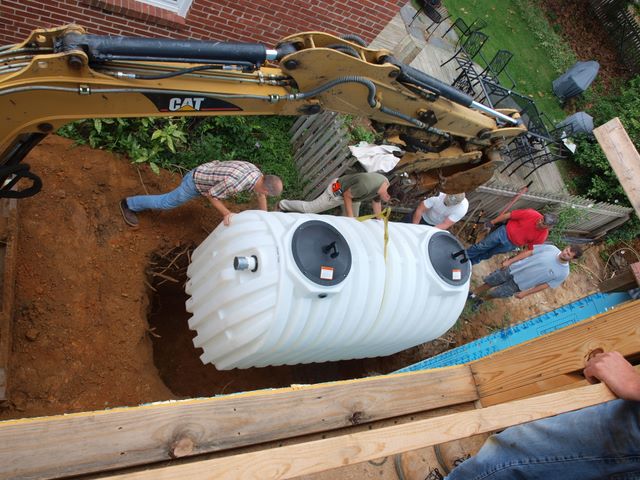Make It Rain!
evan Filed Under: Tags: cistern, city of richmond, combined sewer, Hurricane Gaston, James River, windowsCLICK IMAGE FOR GALLERY
The job site has come back to life in recent days, with windows and cisterns and actual magic, so I suppose it's well past time to fire up the ol' blog engine!
Jeremy installed the JELD-WEN double-hung windows in the new half of the house last weekend, and we're looking at two more weeks until the big units come in. All of the windows will qualify for the "Exceptional Windows" LEED-H Credit, which means that in the EPA North Central Region- which Virginia occupies (sorry secessionists!)- all windows must have a U-value of ≤ 0.32 and a Solar Heat Gain Coefficient of ≤ 0.40.
After yet another bout of massive hole digging, our 1,400 gallon cistern went in yesterday. Initially the thought was really just to catch rainwater from the roof and use it for drip irrigation; however, Richard @ Hollyport Ventures really pushed everyone to maximize our usage of this rainwater. Working with the very helpful Rainwater Management Solutions out of Charlottesville, the team developed a cistern design that will allow us to primarily flush the dual-flush toilets with rainwater instead of treated potable municipal water, and provides drip irrigation as a secondary cistern function. This should significantly lower homeowner utility bills as well as help reduce strain on the municipal storm water and waste water treatment systems. Look for future water efficiency posts as we install a structured plumbing system and low-flow fixtures.
This cistern system required Richmond City approval of a code modification request to allow use of non-potable rainwater inside the house for flushing toilets. Local government takes a lot of knocks, but the city was very receptive and responded quickly to our request, and we're really excited to see this degree of flexibility and decisive leadership downtown.
The water issue is particularly important in Richmond: the city has a combined sewer and storm water overflow. From the city's website:
"During dry weather, combined sewer systems carry all the sanitary flow to wastewater treatment plants. During times of rainfall, however, the amount of rainfall adds to the amount of flow going to the treatment plant. This heavier flow is greater than the capacity of the combined sewer system. When the flow exceeds, the capacity, the excess flow is discharged directly to the river at various overflow points in the sewer system. In Richmond, the major overflow points are found on the banks of the James River and Gillies Creek."What's that? Are these overflow points near where you swim and fish and go on dates or take your in-laws when they visit?
Probably.
Along these lines, the city has a recent history of both smaller and more significant floods that stem from an inability of the existing stormwater system to deal with major rainfall events. We're still seeing and feeling the fallout five years after the Hurricane Gaston flood in 2004. While the city attempts to do its part, Richmond businesses and developers have an imperative to minimize demand from new buildings on an already overwhelmed system, and furthermore have the opportunity to actively reduce demand by incorporating strategies like green roofs and rainwater collection systems into existing structures.
|ETM
Thanks for reading. We'd love to hear comments, questions or suggestions either in the comments section or you can email us at blog@rmichaelcross.com
